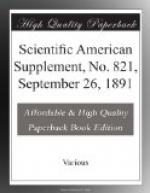The tar paper industry has, within the last forty years, assumed great dimensions, and the preferences for this roofing are gaining ground daily. In view of the small weight of the covering material, the wood construction of the roof can be much lighter, and the building is therefore less strained by the weight of the roof than one with the other kind, so that the outer walls need not be as heavy. Considering the price, the paper roof is not only cheaper than other fireproof roofs, but its light weight makes it possible for the whole building to be constructed lighter and cheaper. The durability of the tar paper roof is satisfactory, if carefully made of good material; the double tar paper roof, the gravel double roof, and the wood cement roof are distinguished by their great durability.
These roofs may be used for all kinds of buildings, and not only are factories, storehouses, and country buildings covered with it, but also many dwellings. The most stylish residences and villas are at present being inclosed with the more durable kinds; the double roof, the gravel double roof, and the wood cement roof. For factory buildings, which are constantly shaken by the vibrations of the machinery, the tar paper roof is preferable to any other.
In order to ascertain to what degree tar paper roofs would resist fire, experiments were instituted at the instigation of some of the larger manufacturers of roofing paper, in the presence of experts, architects, and others, embracing the most severe tests, and it was fully proved that the tar paper roof is as fireproof as any other. These experiments were made in two different ways; first, the readiness of ignition




